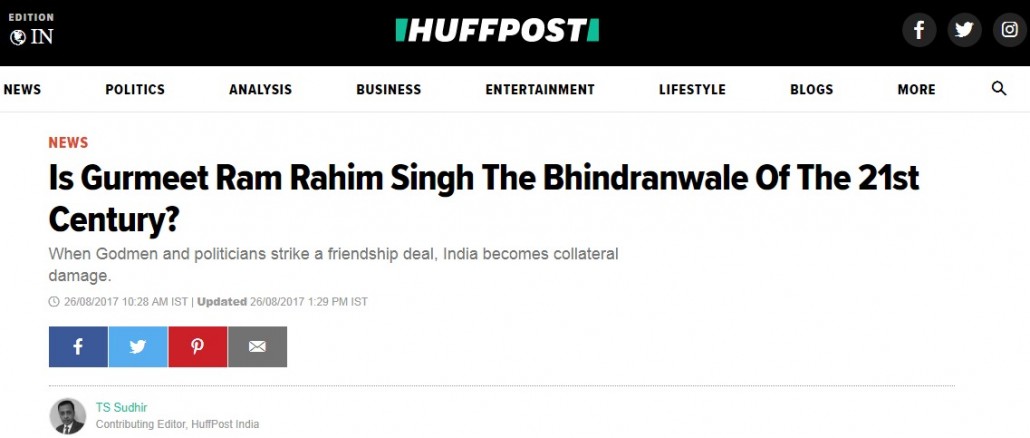The comparisons drawn by TS Sudhir between Gurmeet Ram Rahim and Sant Jarnail Singh Bhindranwale in a recent Huffington Post India article are erroneous at best, and calculated at worst. He takes great pains in his opening ambit to limit the comparisons to “the unholy culture of the politician-godmen nexus in India”. But his selective targeting of the subjects for the article exposes his unashamed blindness towards the countless religious personalities who not only seek to become politically influential at the highest State levels in South Asia, but go on to gain such positions. Three of the key themes underpinning his comparative work are dismantled below.
The argument that Sant Jarnail Singh Bhindranwale was “cultivated by the Congress and goaded to take on the Akalis” is an all too popular myth. Sant Jarnail Singh became the head of the Dam Dami Taksal, the premier Sikh seminary, following the demise of his predecessor in an automobile accident. He was already at that time a highly regarded speaker, gifted teacher and visionary thinker. His rise to prominence over the next few years coincided with the ethical and cultural vacuum that had emerged in Punjab in the early 1980s – his movement to rid households of intoxicating addictions and a sense of helplessness found support and success in equal measure. He was not planted into an influential seat, nor groomed by the State, both of which are utterly despicable to those familiar with the mid-20th Century Taksal and the direction given to its students by the enlightened Sant Gurbachan Singh Bhindranwale and Sant Kartar Singh Bhindranwale respectively, both of whom can be regarded as ‘cultivating’ Sant Jarnail Singh, if anybody at all can make such claim.
Further, in numerous speeches, Sant Jarnail Singh identifies himself as an Akali and connects himself to what it means to be an Akali. He never set out to oppose them, let alone take them on. In fact he fell short of directly criticising the contemporary Akali personalities for their misdemeanours, but reminded them time and again that they, like he, are beholden to the Khalsa Panth who in the form of Sangat will hold them accountable. That his agitation merged with theirs in the Dharam Yudh Morcha is an explicit example of his desire to work with all Sikhs, just as it was desired that he in turn do so by a large proportion of Akalis. That he was ultimately sold out by the Akalis specifically Sant Harchand Singh Longowal, is an indication of the complicity of prominent Akali politicians to toe the line propagated by the State in making a scapegoat of Sant Jarnail Singh Bhindranwale, and the continued assassination of his character by every means available.
Sudhir goes on to assert that Indira Gandhi “flushed Sant Jarnail Singh out of the Akal Takht using the Indian Army” which exemplifies his lack of historical knowledge, specifically how relations between the State and the Sikhs escalated over three decades culminating in the invasion of the Darbar Sahib. Sudhir’s is a simplified statement, repeated often in the mainstream media, without acknowledgement of the agitations that began before partition from the turn of the century onwards, and continued beyond the earliest years of the Indian State coming into being. The continued efforts by Sikh academics and leadership to reach a resolution to their political issues with the Delhi Government resulted in the drafting of the Anandpur Sahib Resolution, on the basis of which Sant Jarnail Singh and his Akali contemporaries engaged the State in a political and later military struggle. Furthermore, suggesting that Sant Jarnail Singh “used political benevolence to further his own interests” diminishes the importance of the Anandpur Sahib Resolution as a statement of intent by the Sikh nation, disregarding the position it held in the political landscape at the time and its significance as the cornerstone of the Dharam Yudh Morcha.
There is a general air of anti-Sikh sentiment throughout the Huffington Post piece, not least of all in the title which aims to antagonise those with experience of recent history, and polarise the Sikh community worldwide. For example, in his comparisons Sudhir brings up Sant Jarnail Singh’s arrest for conspiracy to murder and whilst stating that there was no evidence to be found resulting in all charges being dropped, he goes on to outline the charges laid against Gurmeet Ram Rahim for which there was vast evidence and on the basis of which he was convicted. Any reasonable journalist could not draw a contrast in two such cases, but Sudhir’s aim is not to write with reason, rather to paint a picture that simply brings both figures into the same thought bubble. Littering his article with these notions attempting to draw a comparison between Sant Jarnail Singh who was named as the greatest Sikh of the 21st Century by the Akal Takht, and Gurmeet Ram Rahim who was excommunicated by the aforementioned institution, is an exercise in propaganda, throwing baseless accusation after another onto the page for the idea to take hold. But it is in his concluding statement that Sudhir left me considering the graver, nefarious intentions behind his authoring the article. Sudhir states, “Gurmeet Singh – and I refuse to lend him the holy names of Ram and Rahim – is not the only unholy man who has given trust and belief a bad name.” Aligning Gurmeet Ram Rahim solely with the Sikhs whilst extinguishing his link to the Dharmic traditions of the subcontinent, Sudhir retains usage of the epithet Singh whilst clarifying that holy names Ram and Rahim cannot be attributed to the man. This is a shameful dig at the Sikh nation, implying that the name Singh is not ‘holy’ in the Indian sense, and ultimately depicts, as should be clear from the very title of the piece, that there is no respect accorded to Sikhs in this sphere of the Indian press.





